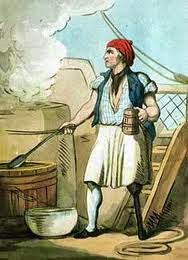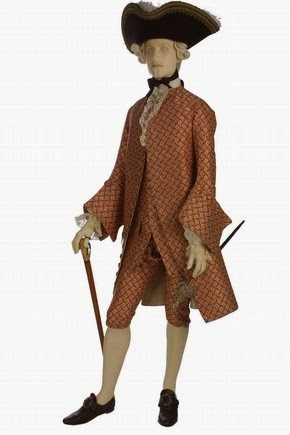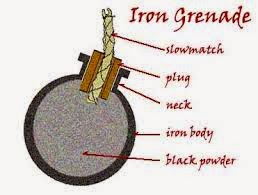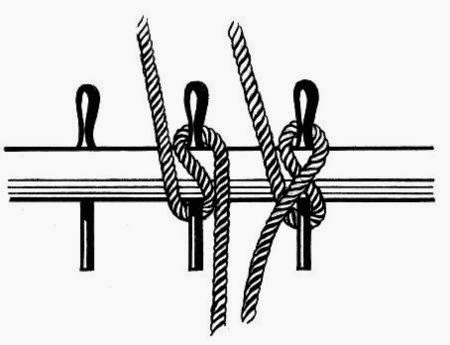Charles Vane was a bad ‘un. He terrorized the Caribbean,
bringing trade to in the area to a halt, tortured his captives, and cheated his
crews out of their fair share of plunder.
A woodblock portrait made from a description shows
a man in a long coat, wearing a gentleman’s wig and carrying a sword. His nose
is hawk-like, and he wear a goatee over a few day’s growth of stubble.
No one knows where Vane came from. He was probably
born around 1680, and likely served as a Navy sailor or privateer during the
War of Spanish Succession. He hung around Jamaica in 1714, and when the Spanish
Treasure fleet wrecked against the coast of Florida in 1715, he joined up with Henry
Jennings, an English privateer captain. He helped Jennings to “acquire” a ship
named the St. Marie and raise a crew
to sail to Florida.
There they fought off all comers in what quickly
turned into a free-for-all. French and Spanish military were trying to salvage
the treasure, while thousands of pirates, privateers, and young men looking to
strike it rich tried to steal part of the gold.
Vane captured enough money to live on for a while,
and when Jennings returned to Jamaica – he still considered himself a lawful
privateer – Vane wandered off to New Providence, already a port run entirely by
pirates.
Vane hung around, drinking whoring and going out
on occasional pirate raids, until 1718. He developed a reputation for beating
up his victims at random, especially ships’ officers. Even if he had already
promised mercy, anything that set him off would cause a violent outburst.
When the English send Woodes Rogers into New
Providence with an offer of a free pardon to any pirate willing to forego his
pirating ways, many pirates celebrated. Vane raised a mob who vowed to remain
pirates forever. When Rogers raised the Union Jack over New Providence’s fort,
Vane attacked the fort, took down the flag, and replaced it with a Jolly Roger,
or as it was called by a witness, “A black flag with a death’s head on it.”
In the meantime, Vane and Jennings sent word to
James Stuart, a pretender to the throne of England, offering to become James’
navy, in exchange for a pardon from him, larger war ships, and permission to
make war on England.
James agreed in principal, but was not quick to
send the required ships. In the meantime, the leaders of the largest body of pirates,
Hornigold and Jennings, advised the pirates to accept the pardon, while
arriving ships laden with treasure reminded the pirates of how profitable their
profession could be. At last a major council was held, but some of the pirates
came in drunk, and in no time at all everyone was shouting.
The council broke up in the most literal fashion,
with pirates heading out in all directions, some to take the pardon in other
ports, some to plunder new ships, some to hunt for another pirate port.
Vane acquired the sloop Lark and began outfitting it for use as a pirate ship. But enough
pirates were angry with him for one reason or another that, when the Navy ship Phoenix captained by a man named Vincent
Pearse.
Pearse found Vane and his crew and blocked the small
cove where they were working on their new ship. The pirates decided to pretend
that they were planning to sail their new ship to meet Pearse and take the
pardon, but they were not believed for a moment. Instead, Pearse arrested them
and took them back to New Providence for execution.
But while the rank-and-file pirates didn’t like
Vane, the leaders of the pirate community did not want to see one of their own
hanged in what had almost been the capital of a pirate nation. They rowed out
to the Phoenix as it lay in Nassau Harbor
and demanded that Vane be set free. Pearse finally agreed, and in return a
veritable who’s who of the pirate world lined up to be pardoned for their crimes.
Captain Pearse must have thought that he had it
made, but a few days later his was probably disappointed when his celebration
of the Price of Wales’ birthday was marred by the pirates setting a boat on
fire and trying to steer the flaming hulk into his ship.
Worse came later. Vane and a group of his friends
snuck off in the night in rowboats and captured a small merchant vessel. They
brought it back to Nassau Harbor, entering by a natural “back door” and
plundered the ship in shallow water, where the much larger Phoenix could not go.
Vane paraded his success through, even though
Pearse fired on him repeatedly, and the number of Vane’s followers tripled in
only three days. Right under Pearse’s nose, they outfitted a pirate ship, which
they renamed the Ranger. They then
went out to terrorize the Caribbean.
Vane captured 12 ships in less than 6 weeks. He tortured
the crews, hanging one man, placing lihted matches in the eyes of another, beat
the passengers, flogged the captains. He kept some of the ships he captured.
He returned to New Providence and made the place
his own. The Phoenix had departed.
Then another large pirate ship sailed into the harbor. Blackbeard, having newly
acquired the Queen Anne’s Revenge had
come home.
For a month, the pirates partied, waiting for word
from the Stuarts in France. But the Pretender’s cause was in decline, and after
a while Vane realized that he’d have to get his own war ship. He gathered his
friends and went hunting.
They captured ship after ship, building a pirate
armada and frequently making trades for large and larger ships. Vane renamed
each ship the Ranger in turn. Finally
they returned to Nassau Harbor.
This time while they were enjoying their spoils,
two British warships entered the harbor. Unable, in his larger vessel, to run
out the “back door.” So the pirates
grabbed every useful thing in the port, from farm animals and supplies to a
skilled carpenter they roused out of bed.
They sent a fire-ship at the British and escaped
in the confusion. But realizing that they were unlikely to ever return to their
former home was not encouraging. And by now Vane knew his deal with the Stuarts
wouldn’t work out. For weeks, the ships floated on the waves while the pirates
devoured their supplies and remained drunk.
When they finally found a ship to attack, Vane
thought they were overmatched. He decided to break off the engagement and run.
This was not popular with the crew. Vane’s second in command, Jack Rackham,
deposed him as captain, putting Vane and his few supporters adrift in a pair of
rowboats.
The boats were separated in a storm, and Vane ended
up alone on a desert island. He was supported by turtle hunters who, knowing
his identity, gave him supplied but refused to allow him on their boats.
Vane finally found someone who didn’t recognize
him, joined the merchant’s crew and was working as a common sailor when he was
outed by one of his former crew members. He was arrested and hauled into
Kingston Jamaica, where he was tired and hanged on March 29th, 1721.
His body was left hanging in the harbor as a
warning to other pirates until it disintegrated.




























